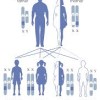Immune status of blood product recipients
Abstract
Persons with hemophilia are at risk of the acquired immunodeficiency syndrome (AIDS), and clinically asymptomatic hemophiliacs have shown a high incidence of AIDS-like immune abnormalities, facts leading to speculation that many hemophiliacs have been exposed to the AIDS agent through their blood products.… Read more
